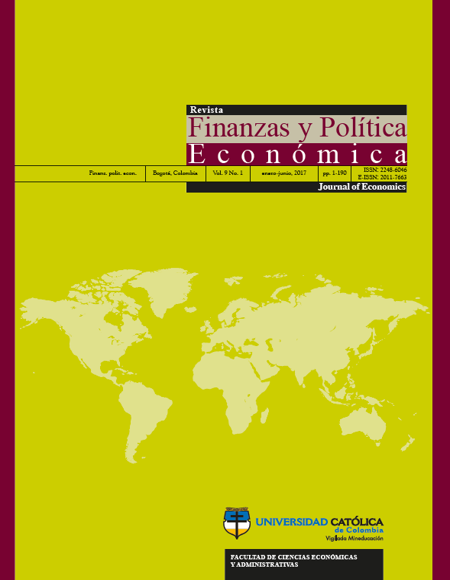
This work is licensed under a Creative Commons Attribution-NonCommercial-ShareAlike 4.0 International License.
This journal is licensed by a Creative Commons Attribution License (CC BY-NC-SA 4.0) Attribution-Non Commercial 4.0 International. For the CC licenses, the principle isthe creative freedom. This system complements the copyright without opposing it, conscious of its importance in our culture. The content of the articles is the responsibility of each author, and does not compromise in any way, to the journal or the university. It allows the transmission and reproduction of titles, abstracts and full content, with academic, scientific, cultural ends, provided acknowledgment of the respective source. This work cannot be used for commercial purposes.
They journal does not charge authors for submission or publication.
Abstract
This paper analyzes the impact of the Federal Reserve’s monetary policy in the United States during the period 2007-2015 on three Colombian economic indicators: the representative market rate (TRM), the COLCAP Index, and fixed income securities (TES) with a coupon rate of 11% per annum. It also looks at EDF announcements one year before the crisis, during the implementation of the program between 2008 and 2014, and one year after the end of the program, when it is decided that monetary policy will be tightened in December 2015. The article starts with an overview of the outstanding causes of the crisis, reviews the main research carried out on the subject highlighting the impact on financial assets in different economies, and it finally explains the event methodology applied with an EGARCH model in the analysis results. The study concludes that announcements on the EDF’s monetary policy in the established period of analysis significantly impacted the COLCAP and TRM indicators in windows of 3, 5, and 7 days, in 87 % of the cases. The 11 % TES coupon variable did not allow to be analyzed as explained in the final conclusions.

References
Alegría, L. F. (2013). ¿Cómo se originó la peor crisis financiera de la historia? Revista Gestión. Recuperado de http://gestion.pe/economia/como-se-origino-peor-crisis-financiera-historia-2076165
Álvarez, G. (2013). La generalización del Quantitative Easing y sus repercusiones en la estabilidad financiera global. Madrid: Instituto Español de Estudios Estratégicos.
Argüelles, D. (2012). Guía para la presentación de trabajos científicos bajo el estándar APA en la Universidad EAN. Bogotá: Universidad EAN.
Barcelata, C. (2010). La crisis financiera en Estados Unidos. Contribuciones a la economía. Recuperado de http://www.eumed.net/ce/2010a/
BBC Mundo (2008). La crisis financiera: una cronología (agosto 2007-septiembre 2008). Recuperado de http://news.bbc.co.uk/hi/spanish/specials/2008/crisis_financiera/newsid_7629000/7629122.stm
Bernanke, B. y Blinder, A. (1988). Credit, money and aggregate demand. The American Economic Review, 78(2), 435-439. https://doi.org/10.3386/w2534
Bernanke, B. y Gertler, M. (1995). Inside the black box: The credit channel of monetary policy transmission. Journal of Economic Perspectives, 9(4), 27-48. https://doi.org/10.1257/jep.9.4.27
Calani, A. (2015). Impacto de la política monetaria en los mercados financieros. Evidencia para renta fija y variable EE. UU. — Colombia — Brasil — Chile — México (tesis de maestría). Santiago de Chile: Universidad de Chile.
Enders, W. (2010). Applied econometric time series (3.a ed.). Hoboken: John Wiley & Sons.
Ferrari, C. (2008). Política económica y mercados. Bogotá: Javegraf.
Gagnon, J., Raskin, M., Remache, J. y Sack, B. (2011). Large-scale asset purchases by the Federal Reserve: Did they work? https://doi.org/10.2139/ssrn.1952095
Gómez J., Leyva, B., Valencia O. y Villamizar, M. (2016). Efectos del Quantitative Easing sobre los retornos accionarios [Borradores de Economía, 929]. Bogotá: Banco de la República.
Gómez, J. y Melo L. (2013). Efecto de los "Angeles Caídos" en el mercado accionario colombiano: estudio de eventos del caso Interbolsa [Borradores de Economía, 779]. Bogotá: Banco de la República.
Hernández, E., Lozano, A. y Morales, R. (2015, 7-9 de octubre). Análisis de la política monetaria Quantitative Easing (QE) implementada en Estados Unidos. En XX Congreso Internacional de Contaduría, Administración e Informática. Ciudad de México.
Hernández, M. (2009). Impacto de las decisiones de la FED, Reserva Federal de los Estados Unidos, en los mercados emergentes Brasil y Colombia, 2002-2006. Bogotá: Universidad de La Sabana.
Joyce, M., Tong, M. y Woods, R. (2011). The United Kingdom is quantitative easing policy: Design, operation and impact. Bank of England Quarterly Bulletin Q3, 51 (3), 200-212.
Krishnamurthy, A. y Vissing-Jorgensen, A. (2011). The effects of quantitative easing on interest rates: Channels and implications for policy brookings papers on economic activity fall. https://doi.org/10.1353/eca.2011.0019
Morales, S. IP (2014). La eficacia de las políticas monetarias de Quantitative Easing llevadas a cabo por la Reserva Federal de los Estados Unidos y por el Banco Central Europeo. Madrid: Universidad Pontificia Comillas.
Neely, C. (2010). The large-scale asset purchases had large international effects. Recuperado de https://research.stlouisfed.org/conferences/qe/Neely_--_2010-018_1_.pdf
Stiglitz, J. (2010). La Caída Libre: el libre mercado y el hundimiento de la economía mundial. Bogotá: Taurus.
Toro, J. (2014). El relajamiento cuantitativo en los Estados Unidos y algunos efectos en Colombia. Reportes del Emisor, 176. Recuperado de http://www.banrep.gov.co/sites/default/files/publicaciones/archivos/re_176_0.pdf
Yamaguchi, K. (2008). Reexamination of stock price reaction to enviromental performance: A GARCH application. Ecological Economics, 68, 345-352. https://doi.org/10.1016/j.ecolecon.2008.04.004





























